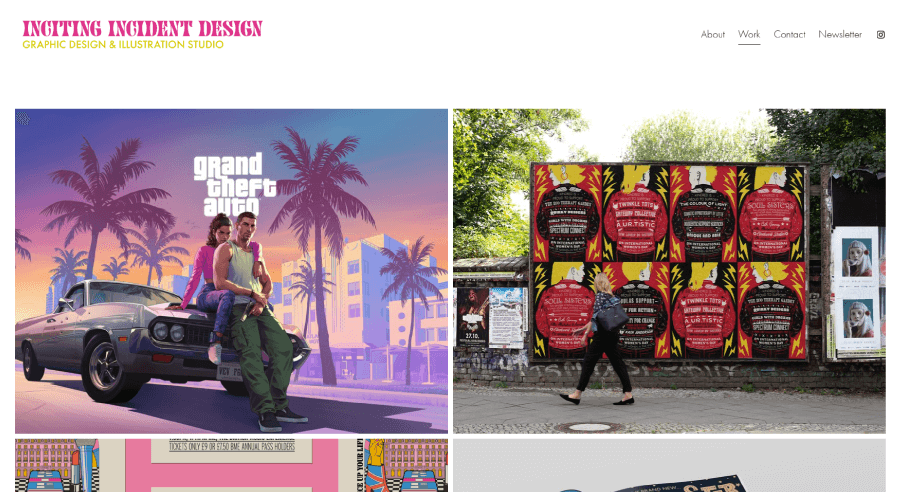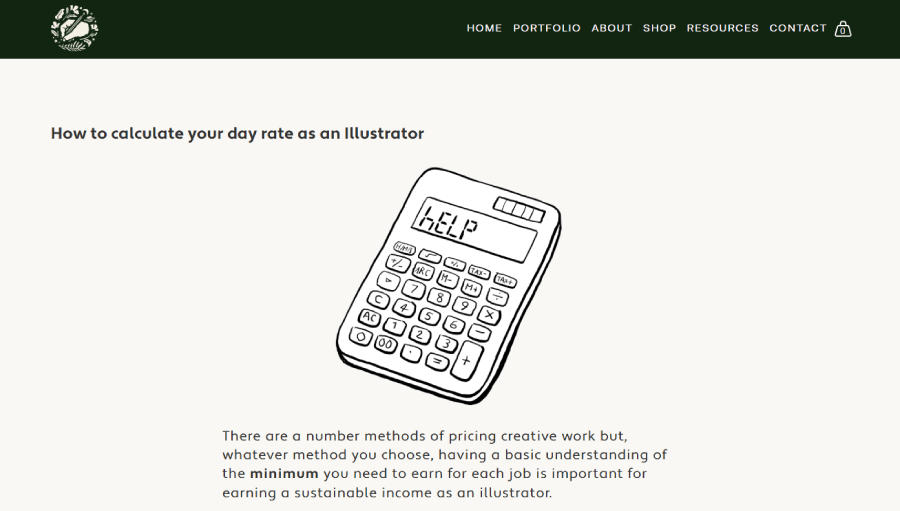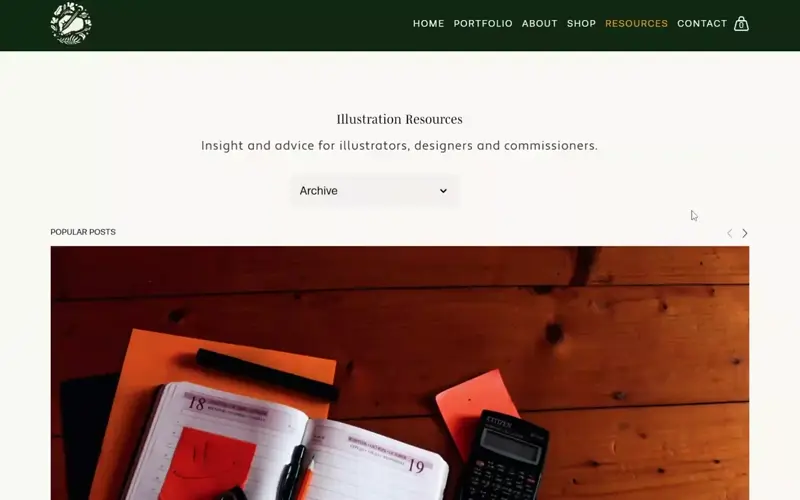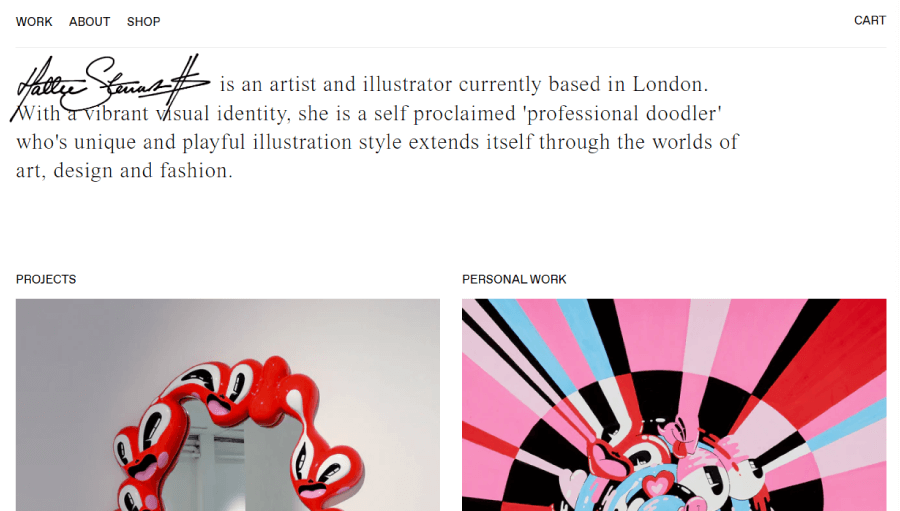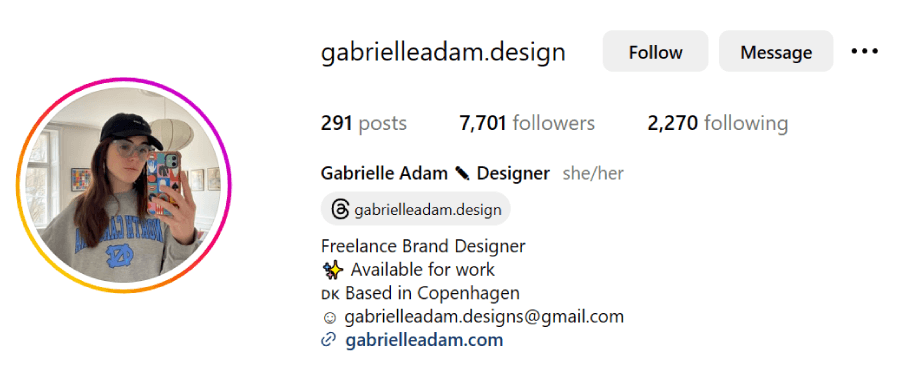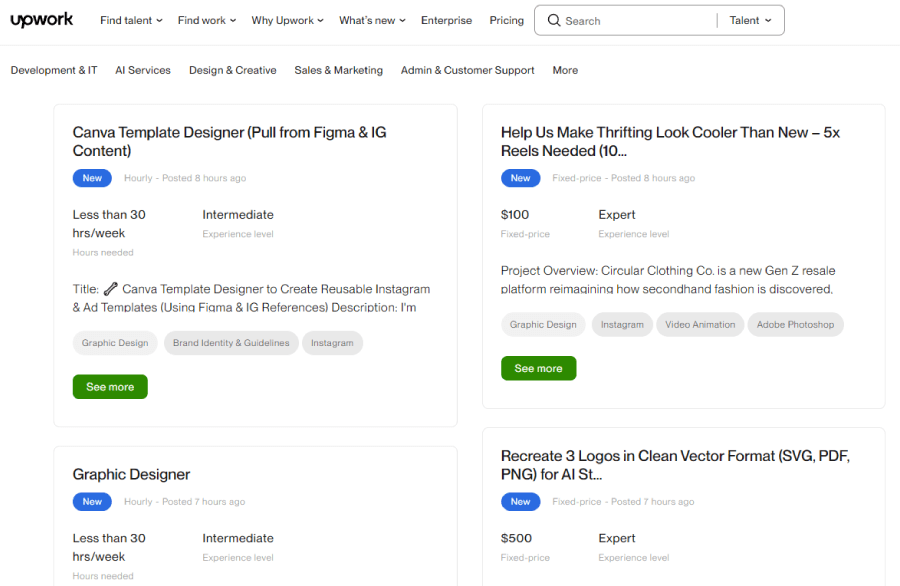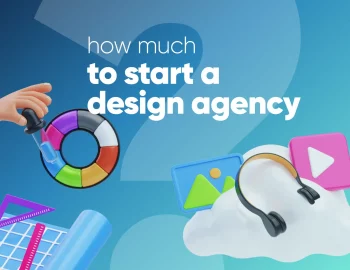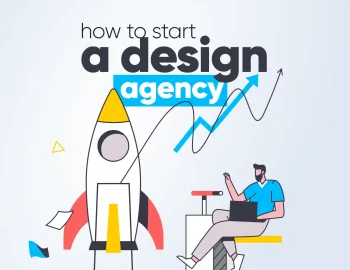Freelancing as a web designer can sometimes feel a little lonely, and figuring out how to find new clients can seem overwhelming or even awkward. You’re not alone in that. Well, it’s good that making real connections doesn’t always have to mean cheesy networking events or pushy sales talk because in the end, it’s about being yourself, helping others, and slowly building a circle of people who know and trust you. This is why I’ll share some good ways to make those connections without stress in this small guide, if you’re a freelancer or a starting design agency.
1. Show your work
If you’re a freelance web designer or a small studio, of course, you’ll need to have a well-designed website that shows your work. After all, your potential clients will decide if you’re worth talking to, so give them something solid to say “yes” to.
🖼️ Start simple, but make it count
Note that way too many freelancers get stuck in the endless loop of perfecting their own site and forget to actually get it out there. The truth is, you don’t even need a five-page masterpiece right off the bat. One clean, well-built page that highlights what you do, who you help, and how to get in touch will do.
Your site needs to load fast, read well, and show off just a handful of your best projects, so don’t overthink it. Just make sure people can find what they need which is usually your style, your services, and a way to reach you.
🖼️ Less can be more
Take a peek at Ethan Suero. His homepage ranks at the top for “Webflow developer”. Why? Because it’s not overloaded with fluff, but ut’s very clean, clear, focused, and optimized to show up in Google searches. That ranking brings Ethan steady traffic, clients included.
🖼️ Own your online real estate
You could use Behance, Dribbble, or even a Notion page to get started. But having your own domain gives you full control. Clients can Google you, find you easily, and feel more confident hiring you.
If you’re not sure where to build your site, WordPress is a good bet. It gives you tons of flexibility, and most importantly, it’s open-source, which means you can make something really great for free. You can start with a basic theme, plug in a few portfolio features, and go from there. The downside for WP is the hosting, because you need to do this yourself.
Another great option is Webflow’s free plan (https://webflow.com/pricing) that comes with hosting (Webflow.io domain), 2 pages, and 50 CMS items. It also has awesome themes for portfolios specifically.
What to include on your site:
- Short case studies (just a few sentences are fine)
- Testimonials from past clients
- Your design process, in plain English
- The kinds of businesses or industries you focus on
- The tools you like using (Webflow, Figma, WordPress, etc.)
- Blog posts or quick tips if you enjoy writing
🖼️ SEO can work while you sleep
If you sprinkle in the right keywords and keep your content updated, your site might start attracting clients on its own. No need for cold outreach or awkward DMs, but only people searching for exactly what you do.
Start with search phrases that make sense for your niche. “Shopify designer for skincare brands” is way better than just “freelance web designer”. The more specific, the better.
2. Use your know-how to get found (without being pushy)
If you’re freelancing as a web designer, your biggest asset, besides your skills, is the stuff you know that others don’t. That’s where content comes in. If you start sharing helpful tips, guides, or even quick how-to posts, you will give potential clients value. This will quietly do the heavy lifting and bring the right people to your site.
You don’t need to go full blogger mode, though. You also definitely don’t need to write 1K-word essays every week. All you need to do is share some quick pieces with tips and insights that help people and show you understand your ideal client and their problems.
✍️ Know who you’re talking to
Before typing anything, think about who you’d actually want to work with. Pet groomers, boutique shops, coaches and consultants, or someone else. Cool. Now ask yourself: What would they Google when they’re frustrated with their current site?
Now, imagine writing the answer.
For example, if you specialize in building sites for yoga teachers, you could write something like:
- “3 website mistakes most yoga teachers make (and how to fix them)”
- “Best booking plugins for solo wellness pros”
- “What to put on a homepage when you don’t know what to say”
You’re basically writing for that one person who thinks, “Wow, that’s exactly what I needed!”.
✍️ Keep it small and real
A short blog post, a how-to video, or even a single-page guide can go a long way. No need to turn into an SEO wizard overnight. Just start with simple questions your clients ask you all the time and answer them clearly.
Here’s a real example. Will Paterson, a freelance designer, built his YouTube channel around helping other creatives and showing his own process. That didn’t build a huge audience and brought Will paying clients and opportunities.
Of course, this is just an example. YouTube content takes a lot of time and strategy to fight the algorithm in itself. But consider starting at least a blog with 3-4 targeted articles can bring in leads through search, especially if your niche isn’t already saturated.
✍️ Focus on topics that actually help
Instead of chasing keywords, think about the real stuff your clients struggle with and answer those things in plain language.
- What kind of website should they even build?
- How much should it cost?
- Can they DIY it, or should they hire someone?
- What should they put on each page?
3. Let people nearby actually find you
If you want to freelance for local clients, you’ve got to help them connect the dots and learn you’re right down the street.
Local search isn’t just for pizza places and plumbers, even if that’s usually the go-to example. It actually works for web designers too, especially if you’d rather meet clients over coffee than over Zoom. Now here’s how you can use it:
🌍 Make your website say where you are
First things first. Your website should say what city you’re in, in a very obvious place, like a line in the footer, your about page, or contact page. You can also put it in your description.
Instead of saying:
- “Freelance Web Designer for Small Businesses”
Try something like:
- “Freelance Web Designer in Austin, Texas, helping small businesses look legit online”
This helps search engines figure out who you help and where you are.
🌍 Set up your Google Business profile (yes, even as a freelancer)
Even if you work from your kitchen table, you can still show up on Google Maps when someone searches “freelance web designer near me”. Just create a free Google Business Profile, link it to your site, and fill it out with your service area.
If you’re afraid of listing your home address, you can hide it and just show the city or area you serve.
Example: A freelance designer in Asheville can set their service area to “Asheville + surrounding areas” without a physical address. Their profile will still show up in local searches, with client reviews and everything.
🌍 Ask happy clients to leave you a Google review
Got a client who’s over the moon about their new site? Ask them to write a short review on Google. Doesn’t need to be long, just honest.
Even five reviews can bump your profile higher when someone nearby searches for a designer. And yes, people do read them.
🌍 Slip your city name into your content (naturally)
You don’t need to keyword-stuff every page, but it helps to casually mention your city or region in your content, blog posts, or testimonials.
A couple of quick examples:
- “I’ve worked with several restaurants around Portland who needed websites that show off their menus and vibe.”
- “Local nonprofits here in Denver often come to me with outdated sites and no clue where to start.”
4. Show up where your clients already are
This doesn’t mean to post five times a day or chase every social app under the sun. But you can still show up where your potential clients hang out and be helpful when you get there.
Freelance web design is part design, part conversation, meaning clients will find you when you’re part of the same digital spaces they already trust.
Now, let’s break this down.
🏠 Pick one place to start
Trying to be active on every social platform will drive you nuts. Most of us don’t have time for that and you don’t need to.
Start by asking:
- Where do my clients already spend time online?
- Are they active in local Facebook groups?
- Do they scroll Instagram for small biz inspiration?
- Are they in Slack communities for startups or creatives?
Let’s say you’re building websites for yoga studios. Instagram might be a better fit than LinkedIn. If you’re into SaaS or B2B websites, then LinkedIn or X might make more sense.
🏠 Don’t just post, talk to people also
Especially when it comes to communities and groups, it’s very important to be present and reply to questions or leave thoughtful comments. Even better if you celebrate someone’s product launch, answer basic design questions in threads, or offer a quick design tip when someone asks for feedback. This can get you steady referrals even from group members you’ve never even spoken to directly.
🏠 Use hashtags like a local
Follow hashtags like #smallbusiness or #websiteredesign, plus local tags like #AtlantaBusiness or #SeattleMakers, to spot people who are starting something new or asking for help.
If someone posts about launching a shop or opening a studio, that’s your cue to leave a helpful comment. Of course, you’re just showing up as someone who knows what they’re doing, don’t scare them with sales-pitching yet.
🏠 Make your profile clear and inviting
If someone clicks your profile, make it easy for them to figure out what you do.
For example:
🎨 Helping small shops and indie brands clean up their online presence
📍 Based in Portland, working with folks everywhere
🔗 [link to your site]”
Add a pinned post with your work or a short “here’s what I do” intro. You want them to land on your profile and immediately know they’re in the right place.
🏠 Helpful = hireable
Every time you share something useful like a blog post, a Twitter thread, or a quick reel, you’re giving people a reason to remember you.
This helps people see you as someone who knows their stuff without ever needing to say, “Hey! I’m an expert”, and start trusting your skills.
It’s rare to have a niche right from the very start, but if you’ve got one, lean into it. It makes creating content easier and helps your name stick when someone needs that exact thing.
5. Get in front of new people (without feeling like a marketer)
Sometimes, the easiest way to meet new potential clients is to show up in places where someone else has already built an audience. Guest posts, podcast interviews, and email newsletter features. These all sound great and they are, if you go about them the right way.
Instead of sending a random pitch to every design blog or podcast host you can find, start with people you already know, follow, or admire. If you’re not sure where to start, try some of these:
- Pitch a helpful how-to article to a blog your audience already reads.
- Reach out to a small podcast or livestream host and offer a specific topic idea you could chat about.
- Swap shoutouts with someone in a related space, maybe a copywriter, branding expert, or SEO freelancer.
6. Start with the people you already know
Honestly, you probably know someone right now who needs a website or knows someone who does.
👨👩👧👦 Your inner circle has more potential than you think
Think of family, friends, old coworkers, your neighbor’s cousin who just opened a shop. There’s a whole web of connections you’ve already got but haven’t tapped into yet.
Who knows, maybe you can find your first client at your gym. You can casually mention you do freelance web design in a conversation, and your gym friend could send you a lead.
That’s how it often happens. You plant a few seeds, and someone sends something your way.
Here are things that work:
- Post on your personal social accounts (even if you rarely use them) that you’re taking on web design clients.
- DM a few old coworkers or classmates, “Hey, just wanted to let you know I’m freelancing now, in case you hear of someone who needs a website.”
- Go through your Facebook or LinkedIn connections and jot down 10 people who might know someone.
It doesn’t have to feel weird or pushy. You’re not selling an MLM pyramid scheme, just letting people know what you’re up to.
👨👩👧👦 Other freelancers can be a lifeline, too
If you know other web designers or can meet some online, this is another great lead to start. Many freelancers are too busy or get inquiries that don’t fit their skill set. If they like you and trust your work, they might send you their overflow.
Many freelance designers or developers take on projects that other creatives don’t want. Nothing glamorous, but a job is a job and it gives you material for the portfolio.
If you’re just starting out, don’t be afraid to take these smaller “leftover” jobs.
7. Don’t rely on just one way to get paid
Client work pays the bills, sure. But freelancing it’s not always steady. One month you’re booked solid, but the next you may be refreshing your inbox every five minutes. This means you definitely need a second income stream, like an additional service.
You’re just giving people more ways to hire you, learn from you, or buy from you even if they’re not ready for full-on custom design. Here are some ideas:
💸 Templates are paid projects that keep earning
Let’s say you’ve designed a few nice sites for coaches, barbershops, or wedding photographers. You could turn one of those layouts into a template and put it up for sale. Platforms like Gumroad or Creative Market make that pretty easy.
Templates also give people a low-cost way to try your style, which sometimes leads to full projects later. There are even some agencies who use this to get clients. They usually release free or low cost templates and offer clients the option to hire the agency for customizing these templates.
💸 Productized services
Some web designers bundle their services into fixed offerings with a clear scope, timeline, and price.
For example, a “one-day website” package for $800. Or a $300 homepage redesign for a two-day turnaround with zero meetings based solely on a questionnaire.
People love knowing what they’re getting, when, and how much it costs. You’ll love not rewriting proposals every week.
Some freelancers and even agencies offer a flat-fee monthly design subscription for design services. SaaS is a popular model for a reason, after all.
💸 Teaching and sharing what you know
If you’ve been freelancing for a while, you’ve probably picked up a few tricks that beginners would pay to learn. You can:
- Make a mini-course on how to build a portfolio website and sell it for $29.
- Offer a paid webinar on how to work with clients as a designer.
- Create a Notion template to help freelancers manage projects and sell it on Etsy.
You don’t need a big audience to make this work. Just something helpful, for a specific type of person, at a reasonable price to do the trick.
Here are a few more low-key options:
- Affiliate links. If you love a tool (like your favorite WordPress host or design plugin), check if they have a referral program and share what you already use.
- Consulting. Some people don’t need a website, but would want your advice. You can set up a paid call option and you might be surprised who books it.
- Speaking or guest workshops. You can pay for local events, online groups, or bootcamps a small fee to get your name in front of more people.
Pick anything you like if you think it fits your skills and schedule. A few small, steady sources can take the pressure off during slow client months.
8. Places that actually help you find web design work
There are a bunch of solid places where paying clients are looking for people like you. You just need to know where to go and how to show up.
Let’s break this down into categories that make sense.
🎯 Job boards with actual jobs
Upwork
This one gets a bad rap sometimes because it’s very competitive. Also, some clients want you to design a full site for $50. But plenty of freelancers have built a solid income here and not just from low-paying gigs but you’ll need to know what not to apply for.
What works:
- Craft a profile that makes it clear who you help and what kinds of sites you build.
- Skip the race-to-the-bottom listings. Look for clients who know what they need and value good design.
- Take your time writing project proposals that feel human, specific, and not copy-pasted.
Other places to check:
- We Work Remotely (This is great for remote contracts)
- SolidGigs (curated freelance gigs in your inbox)
- PeoplePerHour and Freelancer.com (smaller pool than Upwork but still some good leads)
LinkedIn… but not like that
LinkedIn can actually work if you’re not doing what everyone else is doing (you know, the cold DMs that feel like bad sales scripts).
What works:
- Build connections with people in your niche (agencies, startup founders, marketers, etc.).
- Like and comment on their posts without being weird.
After a bit of rapport, send a helpful message, not a pitch. For example, “Hey, saw your site and I love the branding! One quick thing, though. I noticed your mobile nav disappears on scroll. If you ever need a quick fix or fresh eyes, happy to help.”
That kind of approach opens the door without begging for work. And yes, it works.
Craigslist (Yes, Really)
Hear me out. Craigslist isn’t dead for freelancers. In fact, some clients still use it to post small projects, especially in bigger cities like LA, NYC, or Chicago.
Tips to try:
- Check both the “Jobs > Web/Info Design” and “Services > Creative” sections.
- If you’re posting your own ad, refresh it every few days to stay near the top.
- Don’t just stick to your city. Browse listings in major cities across the country.
It’s not glamorous, but it can lead to real contracts for many web designers.
🎯 High-End Platforms
Toptal
This one is not for beginners because it vets their freelancers and accepts only a small percentage. If you’ve got a polished portfolio, confidence in your process, and solid communication skills, it’s worth a try.
They’re picky, but the clients there tend to have good budgets and clear expectations. Also, if they reject you for some reason, they’ll usually tell you why and how to improve for next time.
Portfolio sites
Dribbble and Behance both double as portfolio platforms and discovery tools because lots of potential clients browse them looking for designers who match their style.
In Behance, you can go wild with how you present your work like animations, context, case studies, etc. If you enjoy writing about your process, this is your playground.
Dribbble is more visual, more compact. You’ll want your visuals to look great in that tiny 400×300 preview, since that’s all people will see at first.
Both can bring inbound leads if you post consistently and showcase the kind of work you want more of.
And one last thing…
None of these platforms will work overnight, but if you treat each one like a tool and not a lottery ticket, they can bring in consistent client work.
9. Start the conversation
Sometimes, waiting for leads to land in your inbox just doesn’t cut it. If you’re serious about picking up better freelance web design projects, you’ve got to go out and make something happen.
This doesn’t mean you need to turn into a cold-calling machine or spam inboxes with “Hi, I build websites” emails. You just need a plan that feels more like starting a conversation and less like selling.
💬 Get specific about who you want to work with
Pick one type of client or industry that actually interests you. Maybe it’s boutique travel agencies, indie SaaS startups, mental health nonprofits, or sustainable fashion brands. Once you’ve picked a niche, make a shortlist of businesses in that space you’d love to work with. Aim for 20-30 names to start.
Example: If you enjoy clean, editorial-style websites and care about the environment, look into ethical skincare brands and make a list of the ones with dated websites.
💬 Reach out like a human being
This can plant seeds and, as a result, grant you permission to keep in touch. You can write a short email like you would to a real person and mention something specific about their business or website. Then, offer a resource, a helpful idea, or even ask for a quick chat.
💬 Keep it rolling
Once you’ve built a small list of people who’ve said, “Sure, send me stuff”, send them an email every month. Nothing long but a few tips, a quick insight, or a case study. That keeps your name top-of-mind without being annoying.
Later on, you can reuse the same outreach framework for a different audience, like local restaurants, B2B consultants, or online educators. You’ll only have to tweak your messages, change up the examples, and repeat the process.
10. Make time for growth (even when you’re busy)
Client projects tend to take over everything. You’ve got deadlines, calls, and revisions and before you know it, three weeks go by without a single move toward finding your next gig.
This is where things get risky. You land a few projects, get buried in work, stop marketing and then you hit a dry spell. Sound familiar?
The trick is to treat business development like actual client work. That means blocking off time for it even when you’re fully booked.
📈 Timing:
Of course, you don’t need to do this daily. A few hours a week is enough to stay visible. Some freelancers block out Friday mornings to update their portfolio, write a blog post, or follow up with warm leads. Others set aside Monday afternoons to brainstorm content or send emails to potential clients.
📈 Intention:
Pick one thing each week and go all in:
- Write and schedule next month’s newsletter
- Update your LinkedIn with a new case study
- Reconnect with a lead who ghosted you three weeks ago
- Build a lead list for a new niche you want to target
Whatever it is, commit to it during that time block.
11. People hire people they know
Most freelance web designers get work through people they already know, like past clients, designer friends, dev buddies, or people they’ve met at some point along the way.
Let’s break this down in a way that makes sense (and doesn’t feel like awkward small talk in a loud room).
💗 Keep old clients in the loop
If a client from last year loved working with you, there’s no reason they shouldn’t know you’re available now. This doesn’t mean spamming them, of course, but a quick email every few months or a helpful update on LinkedIn can be enough. Something like:
💗 Partner up with freelancers
Your next project might come from an SEO consultant, a content writer, or a developer who hates picking fonts. These people already work with clients who need web design and they’ll gladly refer someone who makes them look good.
You can reach out casually and offer to collaborate on a mini side project or help with one of their clients. Build trust first, and leads will follow naturally.
💗 Show up without pitching
Going to local meetups, coworking spaces, or casual design events can help more than most people realize. You don’t need a pitch deck or polished elevator speech. Just be curious and helpful.
Ask what others are working on. Share something useful if you’ve got it. No need to “sell yourself”.
Don’t want to go in person? Online communities work too. Join a Slack group for local freelancers or jump into a subreddit where folks actually talk shop.
💗 Speak or share what you know
A 15-minute talk at a small event or a LinkedIn post with a simple insight can help people remember you (and maybe hire you later).
You don’t need to be a “thought leader” but to sound like someone who knows their stuff and enjoys helping out.
💗 Referrals happen when you’re easy to recommend
Good referrals are rarely forced so if you’re friendly, helpful, and stay top of mind, your name will come up when someone’s looking.
Instead of asking clients to “spread the word”, make it easy for them to do so. Give them a quick summary of what you do and the types of businesses you help like ” Hey, if you know anyone with a slow, clunky website or someone launching a new brand, they’re my kind of people.”
💗 Want steady work? Team up with an agency
Some freelancers like the chase. Others want fewer surprises and more structure. If that’s you, consider subcontracting for an agency.
You will still work on client projects, but someone else will handle sales and admin while you focus on the creative work and still get paid fairly, especially when the agency values your niche.
And yes, plenty of agencies are just small teams of freelancers who decided to work together long-term.
Networking is a word that gives a lot of people the ick, because it often feels fake. It doesn’t have to be. In all, it’s just staying in touch with people who like your work. So show up, help out, and stay in their head when web design work comes up. That’s it.
And there you have it!
When you’re just starting out as a freelance web designer, it’s normal to lean on friends, family, or past coworkers for your first gigs. Many freelancers end up depending on word-of-mouth referrals to keep the work coming, and that can feel like a comfortable place to be. But here’s the thing. Referrals are mostly passive. If things go quiet, you don’t really have a way to bring in new clients on your own.
Also, your current clients usually know people like themselves, so relying only on referrals can limit the kind of projects and clients you attract. The best way to grow your freelance business is to mix things up. You can still keep those referrals coming, sure, but also put some effort into sharing your work and getting yourself out there. It might feel awkward at first, but it’s the best way to take control and find the kind of clients and projects you really want.
If you found this guide helpful and want to get more insight or inspiration, check out what else we have in our blog or jump straight into some of these articles I think you’ll find interesting:



